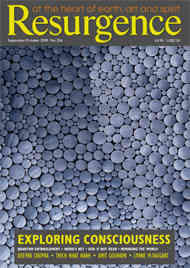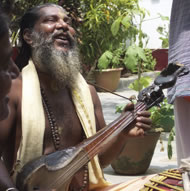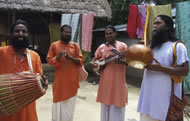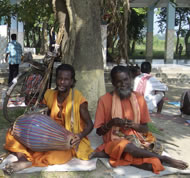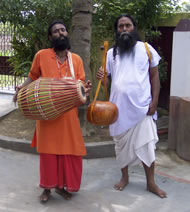Ananda’s home is known as an ashram – meaning ‘a place of spiritual practice’. Baul ashrams are usually small communal groups including extended family members and others. Ananda’s ashram is situated in a poor area of Bolpur, West Bengal, where town and countryside meet, and stands in its own compound with a front gate which is never locked. Ananda considers everyone who enters through his door as his brother or sister. The courtyard is beautifully green with trees, flowers, vegetables and herbs. Every morning and evening, Ananda and others play kirtan and bhajan devotional songs, their music greeting the dawn or fading into the night sky. All Baul music is intimately connected with Nature’s rhythms. Ananda says, “The birds, trees and animals listen to our music and when we sing, we connect with their inner being.”
Ananda comes from a long family tradition of Baul musicians, his father and grandmother both being well-known, talented proponents of the art. His father lives nearby in the house where Ananda grew up. Ananda learned his musical skills from his father, but between the ages of fourteen and sixteen he lived in another ashram with his spiritual guru, to broaden his knowledge.
Ananda explains that his duty as a Baul is to lead a spiritual life in harmony with the natural world and transmit a spiritual message to others through music. He believes strongly in maintaining the traditional styles of his musical culture, and his songs are sung just as they were many years ago. Every day members of his ashram go to local villages to sing and are given donations of food in return. They also sing at people’s houses for special events, anniversaries or festivals. Music is their way of life.
One such festival occurred while I was there – Janmashtami, the celebration of Krishna’s birthday – and we toured the local villages, stopping at houses where people came out to listen and receive blessings. “Singing is a state of meditation,” says Ananda. “We sing to the world around us and to our audience, choosing songs according to the response of our audience.” We eventually returned to Ananda’s ashram where music and dancing went on late into the night.
Baul music combines three elements: tune, rhythm and words, which combine in performance into one experience, creating a state of joy which allows performers and listeners alike to access the divine within.
BAULS HAVE EXISTED in Bengal for over 400 years. They are recruited from both Hindu and Muslim traditions, and are renowned for their rejection of the caste system. There is no religious hierarchy within their community, and their guru is only a spiritual guide. Although fewer in number, women play an equal part with men as musicians.
Ananda’s touring group includes Uma Rani Das who plays khol (a large ceramic drum). Uma began her twelve-year apprenticeship with a guru when she was seven and she spent much of her young life playing on street corners with her father. Ananda, his father and brother, and other members of their troupe have performed together for many years in Kolkata and other parts of India, and more recently in Europe.
The music and singing of Bauls has an immediate and deeply emotional resonance. They play traditional instruments which produce a unique sound, such as the dotara (a plucked lute), the kartal (small cymbals) and ghunur, ankle bells which are played attached to the foot. Flute and sarangi (a bowed stringed instrument) may also be included in an ensemble. The one-stringed ektara has become an emblem of Baul song, and the one string is symbolic of “the one pathway to God”. The beautiful two-stringed percussion instrument known as the anandalahari means ‘waves of joy’. It is this communication of joy which is perhaps the hallmark of Baul music and gives it such immediate appeal.
Bauls had a profound influence on Rabindranath Tagore, the famous Bengali poet, writer, philosopher and social reformer. Tagore first encountered Bauls as a young man when he went to work on his father’s estates in West Bengal. He met the famous Baul Lalon Shah, whose songs are still amongst the most popular today. Tagore incorporated Baul themes into his own poetry, music and drama, often acting the part of a Baul himself in productions of his dramas. It was the human spirit of Baul philosophy which particularly attracted Tagore: “For me, the supreme truth of all existence is the revelation of the Infinite in my own humanity.”
Tagore’s praise of Bauls and his adoption of their themes in his work enhanced their reputation, because in spite of being regarded as saintly musician-mystics, they nonetheless had a low status and lived on the fringes of society. Fortunately, today in West Bengal and Bangladesh, Bauls are becoming more respected by many people for their way of life, their spirituality and their music, and are often seen as representing ideals for a more equal and just society.
In Baul philosophy, there is no separation of body and soul: the human spirit is part of our physical existence, and is intimately connected with equality. “As long as you judge in terms of high and low you are deluded. All are the same to one who knows reality,” said well-known Baul Raj Khyapa. The aim of Baul music is to open the path to god, via song. “Music eventually rises from your inner being through inner consciousness,” says Ananda.
Bauls have maintained their traditions despite violent and radical upheavals in their part of the world, never letting go of their belief in the divinity of the human being. As within any culture, there have been elements of change, but there still remains a central grounded core to Baul philosophy – that of the inherent spirituality of humanity. And Bauls such as Ananda want to share their music and their beliefs with the world. •
To hear examples of Baul music, visit <www.resurgence.org/magazine/extras/>




